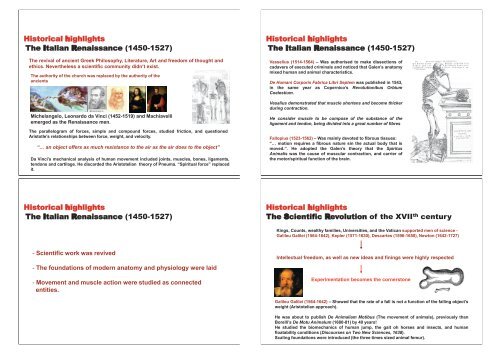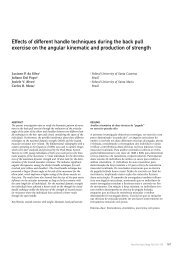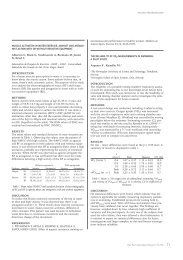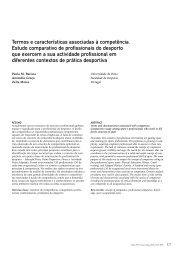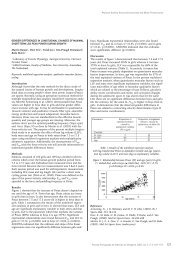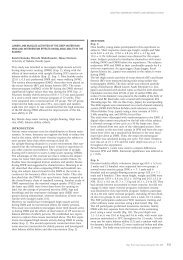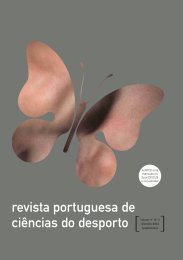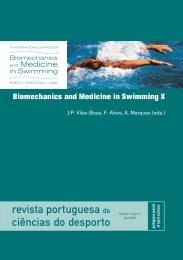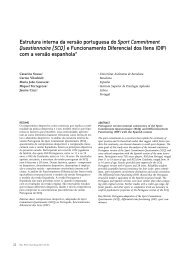Biomechanics
Biomechanics
Biomechanics
You also want an ePaper? Increase the reach of your titles
YUMPU automatically turns print PDFs into web optimized ePapers that Google loves.
Historical highlights<br />
The Italian Renaissance (1450-1527)<br />
The revival of ancient Greek Philosophy, Literature, Art and freedom of thought and<br />
ethics. Nevertheless a scientific community didn’t exist.<br />
The authority of the church was replaced by the authority of the<br />
ancients<br />
Michelangelo, Leonardo da Vinci (1452-1519) and Machiavelli<br />
emerged as the Renaissance men.<br />
The parallelogram of forces, simple and compound forces, studied friction, and questioned<br />
Aristotle’s relationships between force, weight, and velocity.<br />
“… an object offers as much resistance to the air as the air does to the object”<br />
Da Vinci’s mechanical analysis of human movement included joints, muscles, bones, ligaments,<br />
tendons and cartilage. He discarded the Aristotelian theory of Pneuma. “Spiritual force” replaced<br />
it.<br />
Historical highlights<br />
The Italian Renaissance (1450-1527)<br />
- Scientific work was revived<br />
- The foundations of modern anatomy and physiology were laid<br />
- Movement and muscle action were studied as connected<br />
entities.<br />
Historical highlights<br />
The Italian Renaissance (1450-1527)<br />
Vasselius (1514-1564) – Was authorised to make dissections of<br />
cadavers of executed criminals and noticed that Galen’s anatomy<br />
mixed human and animal characteristics.<br />
De Humani Corporis Fabrica Libri Septem was published in 1543,<br />
in the same year as Copernico’s Revolutionibus Orbium<br />
Coelestium.<br />
Vesalius demonstrated that muscle shortens and become thicker<br />
during contraction.<br />
He consider muscle to be compose of the substance of the<br />
ligament and tendon, being divided into a great number of fibres<br />
Fallopius (1523-1562) – Was mainly devoted to fibrous tissues:<br />
“… motion requires a fibrous nature sin the actual body that is<br />
moved.”. He adopted the Galen’s theory that the Spiritus<br />
Animalis was the cause of muscular contraction, and carrier of<br />
the motor/spiritual function of the brain.<br />
Historical highlights<br />
The Scientific Revolution of the XVII th century<br />
Kings, Counts, wealthy families, Universities, and the Vatican supported men of science -<br />
Galileu Galilei (1564-1642), Kepler (1571-1630), Descartes (1596-1650), Newton (1642-1727)<br />
Intellectual freedom, as well as new ideas and finings were highly respected<br />
Experimentation becomes the cornerstone<br />
Galileu Galilei (1564-1642) – Showed that the rate of a fall is not a function of the falling object’s<br />
weight (Aristotelian approach).<br />
He was about to publish De Animaliam Motibus (The movement of animals), previously than<br />
Borelli’s De Motu Animalum (1680-81) by 40 years!<br />
He studied the biomechanics of human jump, the gait oh horses and insects, and human<br />
floatability conditions (Discourses on Two New Sciences, 1638).<br />
Scaling foundations were introduced (the three times sized animal femur).


